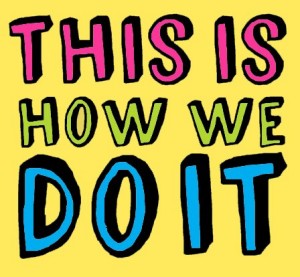W ith the roots of lean and arguably Agile in the Toyota Production System and Scrum first mentioned in ‘The new new product development game’ there are many Japanese terms used in Agile today.
ith the roots of lean and arguably Agile in the Toyota Production System and Scrum first mentioned in ‘The new new product development game’ there are many Japanese terms used in Agile today.
My concern is the barrier this creates to understanding and the perceived learning ramp for those interested in Agile. In a pragmatic scrum vein I have listed the most popular Japanese terms, a replacement term in English and a brief explanation.
This post is a bit different from usual, dictionaries do not have pictures (once you’re over four at least) so this post looks sparse. I am also not going into the detail or history for each word (however interesting), only how it is relevant today for Scrum. So in alphabetical order lets begin…
- Andon – Visual Indicator – A display, siren or other indicator to communicate information and encourage immediate resolution to problems. A live build and test dashboard on a wall-mounted monitor is a good example.
- Dojo – Training Place – A coding club in which to practice exercises (Kata), often by group practice.
- Gemba – Workface – The place at which value is created, the colocated (ideally) team area in Scrum. Management visit the workplace, look around and ask questions to understand what is being done (gemba walk).
- Genchi Genbutsy – Go and See – Similar to management by walking around the principle is going to the source to find the facts, make decisions and build consensus to achieve the correct goal.
- Hansei – Self-Reflection – Recognise and reflect upon mistakes in order to not repeat them. To objectively and critically evaluate tasks to find avenues for improvement.
- Jidoka – Managed Automation – Automating processes to stop when an abnormal condition occurs allowing a developer to eliminate the root causes of an issue. Automation with a human touch has the steps detect, stop, fix immediate concern and investigate to prevent future issues. Continuous integration is an example of Jidoka enabling quality to be built-in.
- Kaizen – Continuous Improvement – Change for the better with small improvements over time accumulating into big results. The retrospective in Scrum is the key point at which to identify improvements and drive the improvement cycle.
- Kanban – Signboard – Scheduling system for work based on pull. In software Kanban is a separate methodology growing in popularity at present.
- Kata – Exercises – Short practice sessions repeated regularly to perform standard exercises with the aim of broadening understanding and improving thinking. Frequently coding the same pattern allows different methods to be experimented with and the short feedback cycle drives improvement. See the code kata website for example coding exercises.
- Stages of Learning:
- Shu – Copying – Beginning stage, concentrating on repeating what is being taught.
- Ha – Reflecting – Expanding upon basic practices by learning the underlying principles and integrating knowledge from other teachers.
- Ri – Extending – Adapting and creating knowledge from your own practice and circumstances.
- The Three Ms of Lean:
- Muda – Waste – Activities not creating value, reducing waste is a key just-in-time method to improve profitability.
- Mura – Unevenness – Unfair demands on process, machines and employees reduces overall productivity.
- Muri – Overburden – Unnecessary stress to process and employees targeted by the Agile manifesto with sustainable development at a constant pace.
- Niko-niko – Happiness Index – A tool used to track the mood of the team. Often a calendar on which developers draw a smiley on as they leave work to indicate their average mood for the day. Note that this produces useful source data for retrospectives.
- Obeya – War Room – A room used by a project to display all project charts and plans, acts as a single location for the team in optimising a project. Visualisation and a shared space improves team interaction.
- Poka-Yoke – Mistake Proofing – Prevent mistakes from occurring or detect them quickly so that they are fixed immediately during development. Examples in software include designing dangerous features out of a language (automatic garbage collection in Java), reminding users there is no title on an e-mail before sending or highlighting invalid commands within an IDE.
- The 5S Methodology –
- Seiri – Sort – Removal of unnecessary items and removal of obstacles.
- Seiton – Systematic Arrangement – Arrange necessary items to make workflow smooth and easy.
- Seiso – Shine – Keep the workplace safe and easy to work within plus use the cleaning process to also maintain required equipment.
- Seikutsu – Standardise – Create processes to reinforce good practice, maintain orderliness and organisation.
- Shitsuki – Sustain – Perform training and regular audits to keep the workplace efficient.
—
That’s it, please send me any other Japanese terms to add to the list along with the English alternative.







